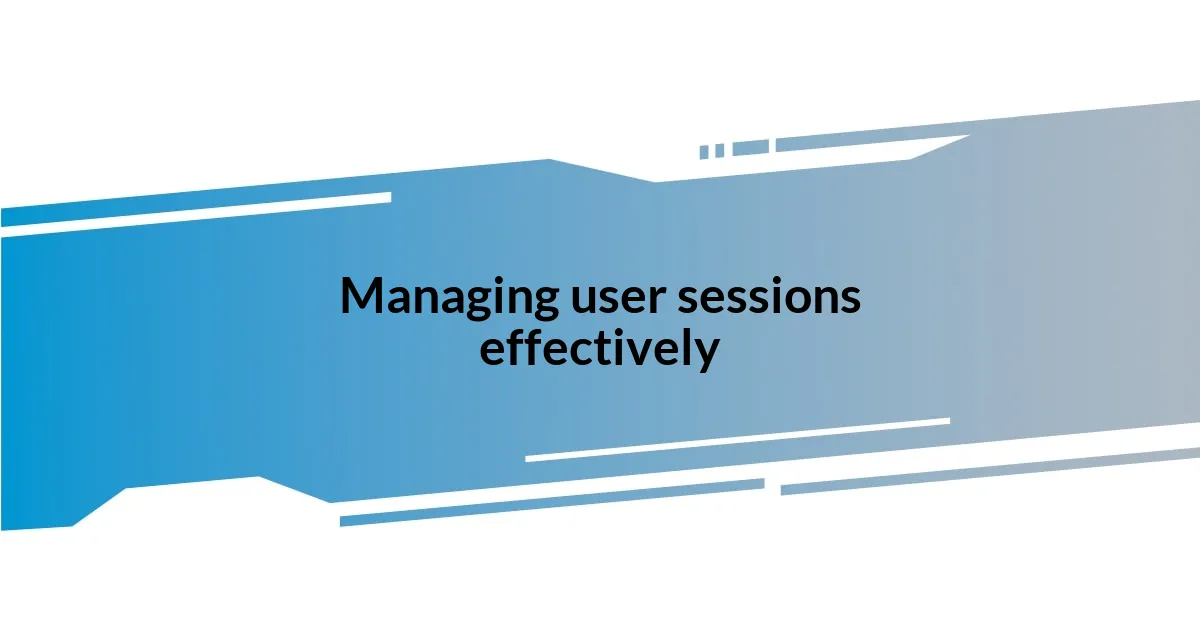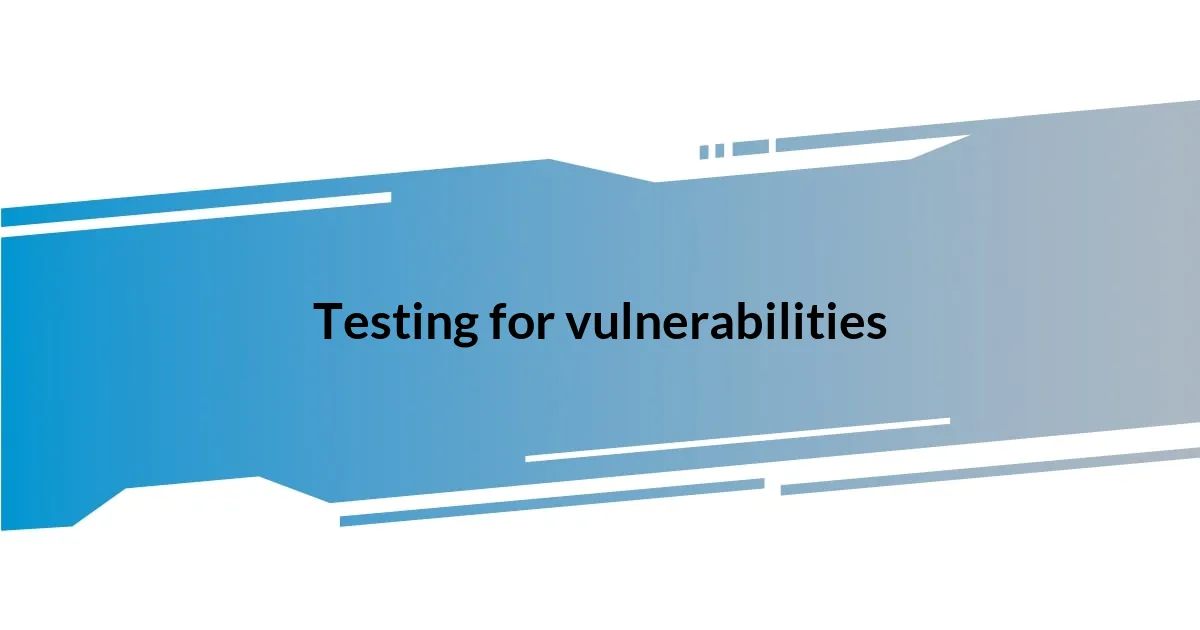Key takeaways:
- Exploring various authentication methods highlights the balance between security (like multi-factor authentication) and user experience.
- Implementing secure password policies and educating users on their importance significantly improves account security.
- Continuous monitoring, user feedback, and regular updates are crucial for maintaining the integrity and security of authentication systems.
- Testing for vulnerabilities through penetration testing and audits reveals weaknesses and fosters a proactive security culture within teams.

Understanding authentication mechanisms
When I first started diving into authentication mechanisms, I was struck by the sheer variety of options available. There are simple methods like passwords and more complex systems like biometric authentication that use fingerprints or facial recognition. I remember experimenting with these different methods, wondering which one would not only be secure but also user-friendly.
Have you ever been frustrated logging into a service that requires you to remember a slew of different passwords? I certainly have! As I explored multi-factor authentication (MFA), which combines something you know (like a password) with something you have (like a mobile device), I realized it significantly increases security without sacrificing convenience. This combination not only protects accounts but also enhances my peace of mind.
Another revelation came when I learned about OAuth, a protocol that allows third-party services to exchange information without revealing passwords. It clicked in my mind how this could simplify my own systems and improve user experience, making online interactions smoother and safer. Have you ever wondered how many apps could be interconnected securely? Embracing such mechanisms can transform how we engage with digital platforms, leaving us feeling both secure and empowered.

Choosing the right authentication method
Choosing the right authentication method is a decision grounded in both security and user experience. Early on in my journey, I found myself torn between the simplicity of passwords and the added complexity of multi-factor authentication (MFA). I remember one incident vividly where I helped a friend reset their password for the third time that week. It drove home the realization that while strong authentication methods are essential, they should also avoid overwhelming users.
When considering authentication methods, here’s a list of factors I always weigh:
- Security Level: Does the method involve multiple factors?
- User Experience: Is it easy for users to understand and use?
- Implementation Complexity: How difficult is it to integrate into existing systems?
- Cost: Are there any financial implications for choosing a specific method?
- Regulatory Compliance: Does it meet industry standards and regulations?
By focusing on these aspects, I find it easier to strike the right balance for my projects.

Implementing secure password policies
Implementing secure password policies is vital for safeguarding user accounts. I once set out to create a password policy while working on an app for a client who underestimated its importance. I clearly remember the long discussions we had about the balance between security and user convenience. To me, a strong password policy should not only encourage complex passwords but also provide users with guidance on how to create them.
When I first introduced character requirements such as uppercase letters, numbers, and symbols, I noticed many users were initially daunted. It was enlightening to see their reactions when I explained that these measures significantly decreased the chance of unauthorized access. I believe that by educating users on the reasoning behind these policies, I cultivated not just compliance but genuine awareness and engagement surrounding password security.
Here is a simple comparison of password policies that I found helpful when designing my own:
| Password Policy Feature | Pros |
|---|---|
| Minimum Length (8-12 characters) | Encourages stronger passwords |
| Character Variety | Increases complexity |
| Regular Password Changes | Reduces risk of old passwords being compromised |
| No Reuse of Previous Passwords | Minimizes the chance of using compromised credentials |
| Password Recovery Options | Offers users a way back into their accounts |

Integrating multi-factor authentication
Integrating multi-factor authentication (MFA) into my projects often feels like stepping up my security game. I remember the first time I implemented SMS-based verification; it was a lightbulb moment. Users seemed reassured knowing they had to provide a second form of identification, and I felt a sense of accomplishment seeing them adopt the extra layer of security without much fuss.
However, I’ve also encountered the challenge of choosing the right MFA methods. On one occasion, I decided to add an authenticator app alongside SMS. While I was excited about enhancing security, I soon realized many users were unfamiliar with setting it up. This experience taught me the importance of clear communication. I found that providing a simple tutorial not only eased users into the process but also transformed initial frustration into empowerment.
As I look back, I often ask myself: how can I make these systems feel intuitive rather than cumbersome? Finding the right blend of security and user experience has become pivotal in my journey. By thoughtfully integrating MFA and providing support, I’ve witnessed firsthand how a secure environment encourages users to feel more confident in their interactions with my systems.

Managing user sessions effectively
Managing user sessions effectively requires a delicate balance between security and user experience. I vividly recall a time when I implemented session timeouts for an application I was developing. Some users found it bothersome to log back in after a brief period, but when I explained that this measure significantly reduced the risk of session hijacking, it led to many users expressing appreciation for the added layer of security. It was gratifying to witness how a collaborative mindset fostered better understanding.
On another project, I experimented with keeping users logged in across devices. Initially, I was hesitant, fearing potential breaches. However, after carefully implementing token-based authentication and notifying users through emails about new device logins, I found a sweet spot. People loved the convenience, and I gained their trust by ensuring they were always in control of their account security. Have you ever felt the relief of knowing your security notices prevent unauthorized access? That’s exactly the reassurance this feature provided.
Monitoring active sessions is equally essential. I once set up an admin dashboard displaying user activity, which allowed me to track session behavior and quickly identify any suspicious activities. It was an eye-opener to see real-time engagement patterns. I realized that not only did it enhance security but also informed us about how our users interacted with the application. This proactive approach not only bolstered trust but also provided valuable insights for future enhancements.

Testing for vulnerabilities
Testing for vulnerabilities is an essential step that can’t be overlooked when building an authentication system. I remember the first time I conducted a security audit on my platform. I felt a mix of excitement and anxiety as I unraveled the potential weaknesses in my system. Conducting penetration testing—where a simulated attack is launched—uncovered several areas that needed immediate attention. It was eye-opening to see what malicious actors could exploit.
During one testing phase, I used tools like OWASP ZAP, and I was surprised to find that a simple misconfiguration allowed unauthorized access to sensitive data. It struck me how easily things could go awry if we didn’t proactively check for such vulnerabilities. I often reflect on how critical it is to stay ahead of the curve. Aren’t we all a bit vulnerable to oversight? Empowering myself and my team to address those issues head-on has since instilled a sense of confidence in our security measures.
After each round of testing, I made it a habit not just to fix the vulnerabilities but to delve deeper into understanding the findings. I shared these insights with my team through workshops, which not only elevated our collective knowledge but also fostered a culture of vigilance. There’s something reassuring about knowing you’re not just ticking boxes, but genuinely enhancing the security fabric of your system together. Have you ever felt that sense of collective responsibility in your projects? It’s a powerful motivator that cultivates a sharper focus on security.

Continuously monitoring and updating
Continuously monitoring the authentication system is not a one-time task; it’s an ongoing commitment. I’ll never forget the time I implemented automated logging for failed login attempts. Initially, it seemed tedious, but I soon realized that each alert represented a potential threat. Those insights not only sharpened my awareness but also allowed my team to proactively respond to unusual activities. Have you ever noticed how those little details can help in preventing something substantial?
Regular updates also play a significant role in maintaining system integrity. I recall a particularly intense week when a critical software update was released. The anticipation was palpable as I delved into the changes, ensuring that our authentication mechanisms remained robust. Updating can feel burdensome, but each improvement is like reinforcing the walls of a secure fortress. How often do you find yourself weighing the costs of such updates against the benefits they bring?
User feedback became another pillar in this continuous development process. After integrating user monitoring tools, I was surprised by the volume of insights that came through. Users reported issues that, although small, could’ve spiraled into significant headaches. Recognizing the value of their experiences transformed how I approached updates. It made me realize that security isn’t just about technology; it’s also about listening to those who interact with it. Have you seen how user feedback can be a treasure trove of inspiration for building a safer environment?